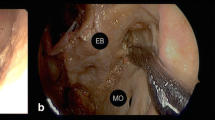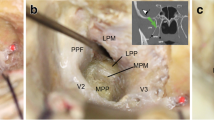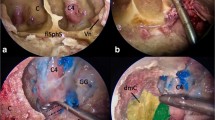Abstract
Resection of midline skull base lesions involve approaches needing extensive neurovascular manipulation. Transnasal endoscopic approach (TEA) is minimally invasive and ideal for certain selected lesions of the anterior skull base. A thorough knowledge of endonasal endoscopic anatomy is essential to be well versed with its surgical applications and this is possible only by dedicated cadaveric dissections. The goal in this study was to understand endoscopic anatomy of the orbital apex, petrous apex and the pterygopalatine fossa. Six cadaveric heads (3 injected and 3 non injected) and 12 sides, were dissected using a TEA outlining systematically, the steps of surgical dissection and the landmarks encountered. Dissection done by the “2 nostril, 4 hands” technique, allows better transnasal instrumentation with two surgeons working in unison with each other. The main surgical landmarks for the orbital apex are the carotid artery protuberance in the lateral sphenoid wall, optic nerve canal, lateral optico-carotid recess, optic strut and the V2 nerve. Orbital apex includes structures passing through the superior and inferior orbital fissure and the optic nerve canal. Vidian nerve canal and the V2 are important landmarks for the petrous apex. Identification of the sphenopalatine artery, V2 and foramen rotundum are important during dissection of the pterygopalatine fossa. In conclusion, the major potential advantage of TEA to the skull base is that it provides a direct anatomical route to the lesion without traversing any major neurovascular structures, as against the open transcranial approaches which involve more neurovascular manipulation and brain retraction. Obviously, these approaches require close cooperation and collaboration between otorhinolaryngologists and neurosurgeons.












Similar content being viewed by others
References
Cavallo LM, Messina A, Cappabianca P, Esposito F, De Devitiis E, Gardner P, Tschabitcher M (2007) Extended endoscopic endonasal transsphenoidal approach to the suprasellar area: anatomic considerations—part 1. Neurosurgery 61:24–34
Anand VK, Schwartz TH (2007) Practical endoscopic skull base surgery. Plural Publishing, San Diego
Jho HD, Ha HG (2004) Endoscopic endonasal skull base surgery: part 1-the midline anterior fossa skull base. Minim Invasive Neurosurg 47:1–8
Cavallo LM, Mesina A, Cappabianca P, Gardner P, Tschabitscher M (2005) Endoscopic endonasal surgery of the midline skull base: anatomical study and clinical considerations. Neurosurg Focus 19(1):E2
Malgro F, Solari D, Cavallo LM, Samii A, Cappabianca P, Paterno V (2006) Endoscopic endonasal approach to the lateral recess of the sphenoid sinus via the pterygopalatine fossa: comparison of endoscopic and radiological landmarks. Neurosurgery 59(ONS Suppl 4):237–243
Kassam AB, Gardner P, Snyderman C, Carrau R (2008) Expanded endonasal approach: vidian canal as a landmark to the petrous internal carotid artery. J Neurosurg 108:177–183
Kassam AB, Gardner P, Snyderman C et al. (2005) Expanded endonasal approach: fully endoscopic, completely transnasal approach to the middle third of the clivus, petrous bone, middle cranial fossa, and infratemporal fossa. Neurosurg Focus 19:E6, 1–10
Brackmann DE, Toh EH (2003) Surgical management of petrous apex cholesterol granulomas. Otol Neurotol 23:529–533
Osborn AG (1980) The vidian artery: normal and pathologic anatomy. Radiology 136:373–378
Snyderman CH, Kasam AB, Carrau R, Mintz A (2007) Endoscopic reconstruction of cranial base defects following endonasal skull base surgery. Skull base: an interdisciplinary approach 17(1):75–76
Yeh S, Foroozan R (2004) Orbital apex syndrome. Curr Opin Ophthalmol 15(6):490–498
Schick U, Dott U, Hassler W (2003) Surgical treatment of orbital cavernomas. Surg Neurol 60(3):234–244
Conflict of interest
None.
Author information
Authors and Affiliations
Corresponding author
Additional information
Presented as an oral contribution at the Annual meeting of the Swiss Otorhinolaryngological Society, 2009 Geneva.
Rights and permissions
About this article
Cite this article
Sandu, K., Monnier, P. & Pasche, P. Anatomical landmarks for transnasal endoscopic skull base surgery. Eur Arch Otorhinolaryngol 269, 171–178 (2012). https://doi.org/10.1007/s00405-011-1698-4
Received:
Accepted:
Published:
Issue Date:
DOI: https://doi.org/10.1007/s00405-011-1698-4




